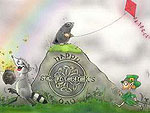March:St. Patrick's Day(圣帕特里克节)
(单词翻译:单击)
| March 17th |
The person who was to become St. Patrick, the patron saint of Ireland, was born in Wales about AD 385. His given name was Maewyn, and he almost didn't get the job of bishop1 of Ireland because he lacked the required scholarship. 385. His given name was Maewyn, and he almost didn't get the job of bishop1 of Ireland because he lacked the required scholarship.
Far from being a saint, until he was 16, he considered himself a pagan. At that age, he was sold into slavery by a group of Irish marauders that raided his village. During his captivity2, he became closer to God. He escaped from slavery after six years and went to Gaul where he studied in the monastery3 under St. Germain, bishop of Auxerre for a period of twelve years. During his training he became aware that his calling was to convert the pagans to Christianity. His wishes were to return to Ireland, to convert the native pagans to Christianity. But his superiors instead appointed St. Palladius. But two years later, Palladius transferred to Scotland. Patrick, having adopted that Christian4 name earlier, was then appointed as second bishop to Ireland.
His mission in Ireland lasted for thirty years. After that time, Patrick retired7 to County Down. He died on March 17 in AD 461. That day has been commemorated8 as St. Patrick's Day ever since. Much Irish folklore9 surrounds St. Patrick's Day. Not much of it is actually substantiated11. Some of this lore10 includes the belief that Patrick raised people from the dead. He also is said to have given a sermon from a hilltop that drove all the snakes from Ireland. Of course, no snakes were ever native to Ireland, and some people think this is a metaphor12 for the conversion of the pagans. Though originally a Catholic holy day, St. Patrick's Day has evolved into more of a secular13 holiday. One traditional icon14 of the day is the shamrock. And this stems from a more bona fide Irish tale that tells how Patrick used the three-leafed shamrock to explain the Trinity. He used it in his sermons to represent how the Father, the Son, and the Holy Spirit could all exist as separate elements of the same entity15. His followers16 adopted the custom of wearing a shamrock on his feast day. The St. Patrick's Day custom came to America in 1737. That was the first year St. Patrick's Day was publicly celebrated17 in this country, in Boston. It was in Boston where the Day was first celebrated in a public way. Gradually other states took it up. And it was New York that took out the largest ever St Patrick' s Day parade. Held since 1762, the New York City parade on St Patrick's Day draws more than one million spectators each year. Meanwhile the city of Chicago has developed a unique tradition of coloring the river water green. It started in 1962 when 100 pounds of green vegetable dye were added to its river, enough to keep it green for a week. The tradition has continued till date. Now, 40 pounds of a green food coloring keep the river green for only a few hours. These apart Irish community in various cities celebrate the Day with social and community works. Making charities, attending mass, promoting their own culture, and feasting with their foods. |
 收听单词发音
收听单词发音
1
bishop

|
|
| n.主教,(国际象棋)象 | |
参考例句: |
|
|
|
2
captivity

|
|
| n.囚禁;被俘;束缚 | |
参考例句: |
|
|
|
3
monastery

|
|
| n.修道院,僧院,寺院 | |
参考例句: |
|
|
|
4
Christian

|
|
| adj.基督教徒的;n.基督教徒 | |
参考例句: |
|
|
|
5
monasteries

|
|
| 修道院( monastery的名词复数 ) | |
参考例句: |
|
|
|
6
conversion

|
|
| n.转化,转换,转变 | |
参考例句: |
|
|
|
7
retired

|
|
| adj.隐退的,退休的,退役的 | |
参考例句: |
|
|
|
8
commemorated

|
|
| v.纪念,庆祝( commemorate的过去式和过去分词 ) | |
参考例句: |
|
|
|
9
folklore

|
|
| n.民间信仰,民间传说,民俗 | |
参考例句: |
|
|
|
10
lore

|
|
| n.传说;学问,经验,知识 | |
参考例句: |
|
|
|
11
substantiated

|
|
| v.用事实支持(某主张、说法等),证明,证实( substantiate的过去式和过去分词 ) | |
参考例句: |
|
|
|
12
metaphor

|
|
| n.隐喻,暗喻 | |
参考例句: |
|
|
|
13
secular

|
|
| n.牧师,凡人;adj.世俗的,现世的,不朽的 | |
参考例句: |
|
|
|
14
icon

|
|
| n.偶像,崇拜的对象,画像 | |
参考例句: |
|
|
|
15
entity

|
|
| n.实体,独立存在体,实际存在物 | |
参考例句: |
|
|
|
16
followers

|
|
| 追随者( follower的名词复数 ); 用户; 契据的附面; 从动件 | |
参考例句: |
|
|
|
17
celebrated

|
|
| adj.有名的,声誉卓著的 | |
参考例句: |
|
|
|

 Patrick was quite successful at winning converts. And this fact upset the Celtic Druids. Patrick was arrested several times, but escaped each time. He traveled throughout Ireland, establishing
Patrick was quite successful at winning converts. And this fact upset the Celtic Druids. Patrick was arrested several times, but escaped each time. He traveled throughout Ireland, establishing 


